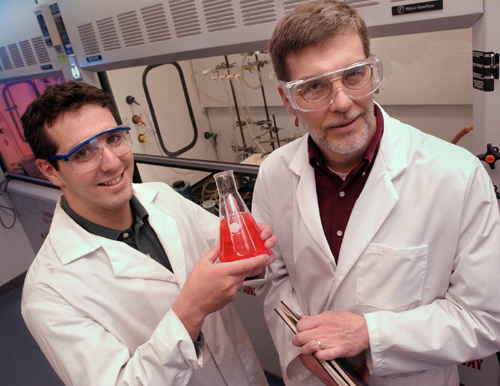The excitement of learning and inventing new things comes with the territory in the Lafayette chemistry lab. This fall, Daniel Ruddy ’03 (Dunmore, Pa.) explored reactions of two types of organic compounds and a special group of catalysts in research with William H. Miles, associate professor of chemistry.
A chemistry major, Ruddy has done EXCEL work in three different disciplines of chemistry: inorganic, analytical, and, most recently, organic.
“In the chemistry department, we think that research is the ultimate learning experience,” Miles comments. “You’re inventing something new and there’s a certain excitement that comes with it. And that’s what we do as professionals for a living. I’m learning new things all the time.”
Miles calls Ruddy “a superb experimentalist” whose independence and self-direction has made him an excellent lab assistant. One of the compounds Ruddy studied in the project was anhydride, an organic molecule that is symmetric through an oxygen atom. The other was tetrahydrofuran or THF, a five-membered ring structure consisting of four carbon atoms and one oxygen atom. The special cataysts are ytterbium trifluoromethanesulfonate hydrate and scandium trifluoromethanesulfonate hydrate.
“When some anhydride, THF, and catalyst are reacted at 90 degrees Celsius, the catalyst causes two THF rings to open and bind, sharing one oxygen, and half of the anhydride attaches to each end, making a dimeric product in good yield,” says Ruddy.
Miles observed this reaction last summer with acetic anhydride (two carbons and a carbonyl group on each side of the oxygen atom) and THF combined with the scandium catalyst, yielding around 75 percent dimer, a high yield for an organic chemistry reaction.
“The fact that the catalyst selectively results in dimers is what makes this project interesting,” says Ruddy. “I continued Dr. Miles’ work with different anhydrides, including proprionic anhydride and benzoic anhydride.”
Both of the anhydrides that Ruddy tried showed the same dimmer selectivity. “This was expected with the proprionic anhydride, since there was only one carbon difference in the side chain, but it was a little surprising when the benzoic anhydride, with a larger and quite different side chain, reacted with similar results.”
A Marquis Scholar who plans to pursue a PhD, Ruddy believes that the skills gained in the research, including lab techniques and instrumentation with a gas chromatography/mass spectra instrument and an NMR instrument, will be valuable beyond his undergraduate years.
“Dr. Miles has been a great professor to work for. He has been patient with my mistakes and has helped with any procedural questions I have had,” says the student. “Like most professors at Lafayette, I do not just do his research. He explains the processes we are observing in the reaction vessel and encourages my input as to where the project is headed.”
Ruddy is treasurer of the student affiliate of the American Chemical Society and a teaching assistant for general chemistry, and participates in intramural sports.

Goldwater Scholarship. Daniel Ruddy ’03 received the premier national undergraduate award of its type in math, science, and engineering. One of his research mentors is William Miles, associate professor of chemistry.
